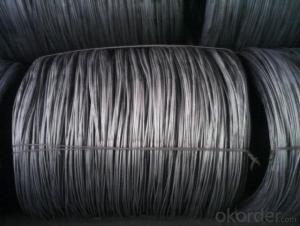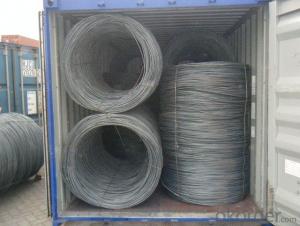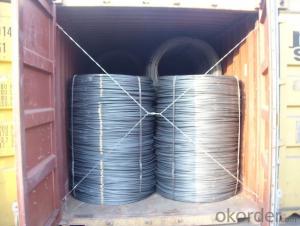Steel Wire Rod Low Carbon and Competitive Prices
- Loading Port:
- Tianjin
- Payment Terms:
- TT or LC
- Min Order Qty:
- 20 m.t.
- Supply Capability:
- 200000 m.t./month
OKorder Service Pledge
OKorder Financial Service
You Might Also Like
Product Description:
OKorder is offering Steel Wire Rod Low Carbon and Competitive Prices at great prices with worldwide shipping. Our supplier is a world-class manufacturer of steel, with our products utilized the world over. OKorder annually supplies products to European, North American and Asian markets. We provide quotations within 24 hours of receiving an inquiry and guarantee competitive prices.
Product Applications:
Steel Wire Rod Low Carbon and Competitive Prices are ideal for structural applications and are widely used in the construction of buildings and bridges, and the manufacturing, petrochemical, and transportation industries.
Product Advantages:
OKorder's Steel Wire Rod Low Carbon and Competitive Prices are durable, strong, and resist corrosion.
Main Product Features:
· Premium quality
· Prompt delivery & seaworthy packing (30 days after receiving deposit)
· Corrosion resistance
· Can be recycled and reused
· Mill test certification
· Professional Service
· Competitive pricing
Packaging & Delivery:
Packaging Detail: products are packed in bundle and then shipped by container or bulk vessel, deformed bar is usually naked strapping delivery, when storing, please pay attention to moisture proof. The performance of rust will produce adverse effect.
Each bundle weight: 2-3MT, or as required
Payment term: TT or L/C
Delivery Detail: within 45 days after received advanced payment or LC.
Label: to be specified by customer, generally, each bundle has 1-2 labels
Trade terms: FOB, CFR, CIF
FAQ:
Q1: Why buy Materials & Equipment from OKorder.com?
A1: All products offered byOKorder.com are carefully selected from China's most reliable manufacturing enterprises. Through its ISO certifications, OKorder.com adheres to the highest standards and a commitment to supply chain safety and customer satisfaction.
Q2: How do we guarantee the quality of our products?
A2: We have established an advanced quality management system which conducts strict quality tests at every step, from raw materials to the final product. At the same time, we provide extensive follow-up service assurances as required.
Q3: How soon can we receive the product after purchase?
A3: Within three days of placing an order, we will begin production. The specific shipping date is dependent upon international and government factors, but is typically 7 to 10 workdays.
Images:
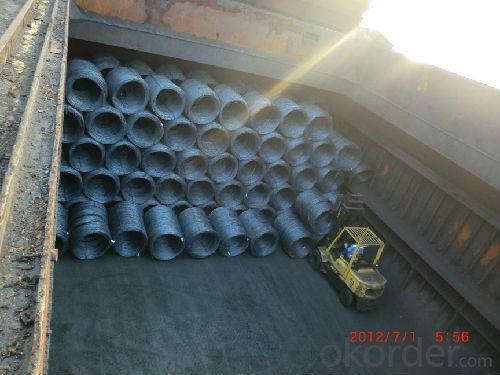
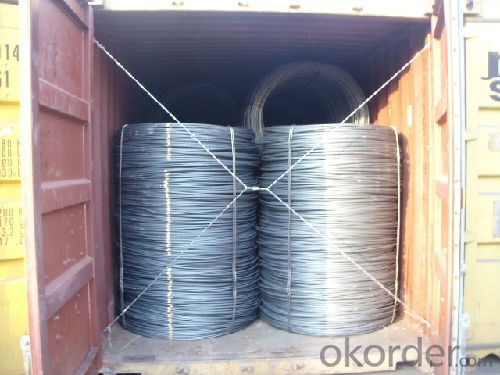
- Q:What are the recent developments and innovations in steel wire rod production?
- Some recent developments and innovations in steel wire rod production include the introduction of advanced wire rod mills that utilize high-speed rolling technologies, such as the MEERdrive® system, to increase productivity and improve product quality. Additionally, there have been advancements in the use of automation and artificial intelligence to optimize the production process, reducing energy consumption and minimizing waste. Furthermore, manufacturers are investing in research and development to develop new alloys and coatings that enhance the strength, durability, and corrosion resistance of steel wire rods, expanding their applications in diverse industries such as automotive, construction, and aerospace.
- Q:How is steel wire rod used in the production of wire brushes?
- Steel wire rod is used in the production of wire brushes as it serves as the main material for the bristles. The wire rod is shaped, cut, and twisted to create the bristles that are then attached to the brush's base or handle. The strength and durability of steel wire make it ideal for wire brushes, allowing them to effectively remove dirt, debris, and rust from various surfaces.
- Q:How is steel wire rod used in the manufacturing of wire rope assemblies for lifting equipment?
- Steel wire rod plays a vital role in the production of wire rope assemblies for lifting equipment. To enhance its strength, durability, and resistance to corrosion, the wire rod undergoes a series of mechanical operations, including drawing, annealing, and coating. Once prepared, the wire rod is transformed into individual wires using a stranding process. These wires are then twisted together to form strands, which are further twisted in a helical pattern around a core to create the wire rope. The specific requirements of the lifting equipment determine the number of strands and the direction of twisting. The utilization of steel wire rod in wire rope assemblies guarantees the necessary strength and load-bearing capacity for lifting heavy objects. Steel wire possesses exceptional tensile strength, enabling it to withstand high loads and maintain structural integrity even in extreme conditions. Additionally, the flexibility and malleability of steel wire make it easily adaptable to various shapes and configurations, making it suitable for diverse lifting applications. Wire rope assemblies crafted from steel wire rod find extensive use across industries such as construction, mining, oil and gas, and manufacturing. They are commonly employed in cranes, elevators, hoists, winches, and other lifting equipment to move heavy loads safely and efficiently. The reliable and robust nature of wire rope assemblies ensures the safety of workers and the integrity of the equipment, establishing them as an integral component in the lifting industry.
- Q:How is steel wire rod used in the production of wire mesh for food processing?
- Steel wire rod is an essential component in the production of wire mesh for food processing. Wire mesh, also known as wire cloth or wire fabric, is a versatile material used in various industries, including the food processing industry. It is commonly used for sieving, filtering, and separating solids and liquids during the production and processing of food products. Steel wire rod serves as the raw material for manufacturing wire mesh. It is a long, cylindrical piece of steel that is formed into coils. The wire rod is selected based on its desired properties, such as strength, durability, and corrosion resistance, which are crucial for its application in food processing. To produce wire mesh for food processing, the steel wire rod undergoes a series of manufacturing processes. The first step involves drawing the wire rod through a series of dies to reduce its diameter and achieve the desired wire thickness. This process is known as wire drawing and is done to increase the ductility and flexibility of the wire. Once the wire is drawn to the desired thickness, it is then woven or welded to form wire mesh. The weaving process involves interlacing the wires vertically and horizontally, creating a grid-like pattern. This pattern determines the size of the openings in the wire mesh, allowing for specific particle or liquid filtration. In the case of food processing, the wire mesh used is typically made of stainless steel wire rod. Stainless steel is preferred due to its high resistance to corrosion, easy cleanability, and hygienic properties. This makes it suitable for applications where food safety and cleanliness are of utmost importance. The wire mesh produced from steel wire rod is used in various ways in the food processing industry. It is commonly used as sieves or screens in food processing equipment, such as vibrating sifters or centrifugal separators, to separate or classify different-sized particles. It can also be used as a conveyor belt or conveyor screen, allowing for the transportation of food products through different stages of processing. Furthermore, wire mesh can be used as protective barriers or covers for food processing machinery, preventing contamination and ensuring worker safety. It can also be used as fencing or enclosures for storage areas or production facilities, providing a secure and controlled environment for food processing operations. Overall, steel wire rod plays a crucial role in the production of wire mesh for food processing. Its strength, durability, and corrosion resistance make it an ideal material for manufacturing wire mesh that meets the stringent requirements of the food processing industry.
- Q:What are the disadvantages of using steel wire rod in manufacturing?
- Using steel wire rods in manufacturing has several drawbacks: 1. Corrosion is a major issue with steel wire rods, especially when exposed to moisture or chemicals. This can significantly reduce the durability and lifespan of manufactured products. 2. Weight is another concern as steel wire rods are relatively heavy compared to alternatives like aluminum or carbon fiber. This can result in a more labor-intensive manufacturing process and increased transportation costs. 3. Limited flexibility is a drawback of steel wire rods, restricting design possibilities and functionality in industries where flexibility is crucial, such as automotive or aerospace. 4. Cost is a significant disadvantage of steel wire rods, particularly when demand for steel is high, leading to increased prices. The manufacturing process for steel wire rods can also involve multiple steps, adding to production costs. 5. Environmental impact is a drawback of producing steel wire rods, as it involves the extraction of iron ore, resulting in deforestation, habitat destruction, and pollution. Additionally, steel manufacturing requires a substantial amount of energy, contributing to greenhouse gas emissions. 6. Maintenance is necessary to prevent corrosion in steel wire rods, which adds to overall costs and time required for product maintenance. This includes applying protective coatings and implementing proper storage methods. 7. Steel wire rods have poor electrical conductivity compared to materials like copper or aluminum. This limits their usability in industries or applications where electrical conductivity is essential, such as electronics or electrical wiring. Overall, while steel wire rods offer advantages like strength and rigidity in manufacturing, they also come with significant drawbacks that need to be considered when choosing materials for manufacturing processes.
- Q:What are the different surface coating materials used for steel wire rod?
- There are several different surface coating materials that can be used for steel wire rod to enhance its properties and protect it from corrosion. Some of the commonly used surface coating materials for steel wire rod include: 1. Zinc: Zinc coating is one of the most widely used surface coatings for steel wire rod. It provides excellent corrosion resistance and acts as a sacrificial layer, protecting the underlying steel from rust and oxidation. Zinc-coated steel wire rods are commonly known as galvanized wire rods. 2. Epoxy: Epoxy coatings are often used for steel wire rods that require resistance to chemicals, moisture, and abrasion. Epoxy coatings provide a durable, smooth, and protective layer that helps to prevent corrosion and improve the overall performance of the wire rod. 3. Phosphating: Phosphating is a surface treatment process that involves the conversion of the metal surface into a layer of phosphate crystals. Phosphating enhances the adhesion of subsequent coatings or paints, providing better corrosion resistance and improving the overall appearance of the steel wire rod. 4. Polymer Coatings: Polymer coatings are commonly used for steel wire rods that require specific properties such as electrical insulation, UV resistance, or high temperature resistance. These coatings are typically made from polymers such as PVC (polyvinyl chloride) or PE (polyethylene) and are applied using various techniques such as extrusion or dip coating. 5. Organic Coatings: Organic coatings, such as paints or lacquers, can also be used as surface coatings for steel wire rods. These coatings provide aesthetic appeal, as well as protection against corrosion and environmental factors. Organic coatings can be applied in various colors and finishes to meet specific requirements. It is important to note that the choice of surface coating material for steel wire rod depends on the intended application, environmental conditions, and desired properties. Manufacturers typically select the most suitable coating material based on the specific requirements of the wire rod and the end-use of the product.
- Q:What are the common industry events for steel wire rod?
- Some common industry events for steel wire rod include trade shows, conferences, and exhibitions specifically focused on the steel industry. These events provide opportunities for manufacturers, suppliers, and industry professionals to showcase new products, discuss trends and advancements, network, and explore potential business opportunities. Examples of such events include the International Wire and Cable Trade Fair (wire), Steel Success Strategies, and the International Steel & Minerals Conference.
- Q:How is the ductility of steel wire rod determined?
- The ductility of steel wire rod is determined through various mechanical tests and measurements. One of the commonly used methods to evaluate ductility is the tensile test. In this test, a sample of the steel wire rod is pulled until it breaks, and the amount of deformation it undergoes before fracture is measured. During the tensile test, the steel wire rod is subjected to an increasing load or force, while its elongation or deformation is continuously measured. The force required to stretch the wire to a specific length is recorded, and the resulting stress-strain curve is plotted. The ductility of the steel wire rod can be determined from this stress-strain curve. The elongation or deformation at the point of fracture is an important parameter in assessing its ductility. Higher elongation indicates greater ductility, as it implies that the material can undergo more deformation before breaking. Apart from the tensile test, other tests such as the bend test and impact test can also be used to evaluate the ductility of steel wire rod. In the bend test, the wire is bent to a specific angle without fracturing. The ability to bend without breaking indicates good ductility. Similarly, the impact test measures the energy absorbed by the wire when it is subjected to a sudden impact. A higher energy absorption indicates better ductility, as it implies that the material can absorb and distribute the impact forces without fracturing. In conclusion, the ductility of steel wire rod is determined through mechanical tests such as the tensile test, bend test, and impact test. These tests measure the amount of deformation the wire can undergo before breaking, the ability to bend without fracturing, and the energy absorption during impact, respectively.
- Q:What are the different storage methods for steel wire rod?
- The storage of steel wire rod varies depending on factors such as quantity, size, and condition. There are multiple methods available. One option is to stack the wire rod neatly and in an organized manner. This involves creating rows of wire rod coils on a stable surface like a concrete floor or a specially designed storage rack. It is crucial to stack the coils in a way that prevents rolling or collapsing for safety and easy access. Another method is to use wire rod racks or shelves. These racks are specifically designed to securely hold wire rod coils and prevent them from rolling or shifting. They often have dividers or compartments to keep each coil separate and well-organized. Vertical racks or stands can also be used, particularly when dealing with longer wire rod lengths. This method saves floor space by placing the rod vertically and securing it in place. For outdoor storage, designated areas with storage containers or shipping containers can be used. This provides protection from the elements and ensures the rod remains in good condition. Regardless of the chosen storage method, it is essential to protect the wire rod from moisture, dust, and other contaminants. This can be achieved by using plastic or metal covers or storing the rod in a climate-controlled environment. It's important to note that the specific storage method may vary depending on industry standards, regulations, and the specific requirements of the wire rod product. Consulting with industry experts or manufacturers is always recommended to determine the most suitable storage method for steel wire rod.
- Q:How is the impact resistance of steel wire rod tested?
- The impact resistance of steel wire rod is typically tested using a Charpy impact test. In this test, a notched specimen of the wire rod is subjected to a swinging pendulum that strikes and breaks the specimen. The energy absorbed by the specimen during fracture is measured, which provides an indication of its impact resistance.
1. Manufacturer Overview |
|
|---|---|
| Location | |
| Year Established | |
| Annual Output Value | |
| Main Markets | |
| Company Certifications | |
2. Manufacturer Certificates |
|
|---|---|
| a) Certification Name | |
| Range | |
| Reference | |
| Validity Period | |
3. Manufacturer Capability |
|
|---|---|
| a)Trade Capacity | |
| Nearest Port | |
| Export Percentage | |
| No.of Employees in Trade Department | |
| Language Spoken: | |
| b)Factory Information | |
| Factory Size: | |
| No. of Production Lines | |
| Contract Manufacturing | |
| Product Price Range | |
Send your message to us
Steel Wire Rod Low Carbon and Competitive Prices
- Loading Port:
- Tianjin
- Payment Terms:
- TT or LC
- Min Order Qty:
- 20 m.t.
- Supply Capability:
- 200000 m.t./month
OKorder Service Pledge
OKorder Financial Service
Similar products
New products
Hot products
Hot Searches
Related keywords
